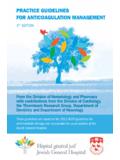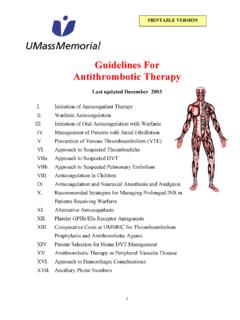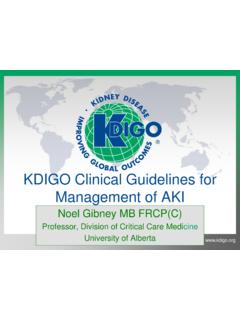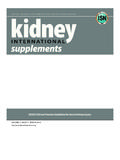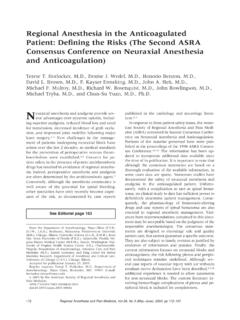Transcription of ASRA/ESRA/INS/AAPM/WIP/NANS guidelines for …
1 1 ASRA/ESRA/INS/AAPM/WIP/NANS guidelines for interventional spine and pain procedures in patients on antiplatelets and anticoagulants Narouze S,* Benzon HT,** Provenzano D,** Buvanendran A,** , De Andres J,# Deer T##, Rauck R,### Huntoon M** *Western Reserve Hospital, Cuyahoga falls, Ohio,**Northwestern University Feinberg School of Medicine, Chicago, Illinois; **Pain Diagnostics and interventional Care, Pittsburgh, Pennsylvania;** Rush Medical Center, Chicago, Illinois; #Valencia University Medical School. Department of Anesthesiology Critical Care and Pain Management .General University Hospital. Valencia (Spain) ,## The Center for Pain Relief, Charleston, West Virginia , ### Carolinas Pain Institute, Winston Salem, North Carolina, **Vanderbilt University, Nashville, Tennessee Drs.
2 Samer Narouze and Honorio T. Benzon equally contributed to the manuscript. 2 Introduction and background A survey was conducted among participants at the Anticoagulation/Antiplatelets and Pain Procedures open forum held at the American Society of Regional Anesthesia and Pain Medicine (ASRA) annual fall meeting in 2012. The purpose of this survey was to determine the safe practice patterns of pain physicians regarding continuance of concurrently administered anticoagulants, timing schedules for cessation and resumption of use, and any use of bridging therapies when planning for various interventional pain procedures.
3 The survey items included specific practice characteristics, and whether active protocols were utilized. Additionally, the survey queried the frequency of adherence to specific elements of the current ASRA practice guidelines for regional anesthesia and/or if respondents incorporated different protocols for different pain procedures. 124 active participants attended the open forum. Responses were collected using an audience response system. 84% of respondents were anesthesiologists and the remainder were physical medicine and rehabilitation physicians, neurologists, orthopedists or neurological surgeons. The vast majority of respondents (98%) followed ASRA regional anesthesia guidelines for anticoagulants but not for antiplatelet agents.
4 Two thirds of the participants (67%) had separate protocols regarding aspirin (ASA) or non-steroidal anti-inflammatory drugs (NSAIDs). Moreover, 55% stopped ASA before spinal cord stimulation (SCS) trials and implants and 32% stopped ASA before epidural steroid injections (ESIs). However, 17% admitted that they employed different protocols for cervical spine injections as compared to lumbar spine injections. Most did not express familiarity with selective serotonin reuptake inhibitors (SSRIs) effects on platelets. Only 36% knew that SSRIs may lead to a bleeding disorder. The majority expressed the need for pain physicians to communicate with other physicians, as 88% stated that they get approval from primary care physicians, cardiologists or neurologists before holding anticoagulants or antiplatelet agents.
5 Based on these results, the need for separate ASRA guidelines , specifically for interventional pain procedures in patients on antiplatelets/anticoagulants, was self -evident. Hence, the Board of 3 Directors of ASRA recommended that the Regional Anesthesia and Pain Medicine journal (RAPM) appoint a committee to develop separate guidelines for The committee has an international representation, and was endorsed by the European Society of Regional Anesthesia and Pain Therapy (ESRA), American Academy of Pain Medicine (AAPM), the International Neuromodulation Society (INS), and the World Institute of Pain (WIP). The latest evidence was sought through extensive database search strategegies.
6 Although the guidelines may not always be based on randomized studies or on large numbers of patients from pooled databases, it is hoped that they will provide sound recommendations and the evidentiary basis for such recommendations. These recommendations are timely as there has been a growing interest in this topic spanning several years, as evidenced by the recent publications of cases of epidural hematoma during pain procedures in patients receiving antiplatelet agents (ASA and NSAIDs).2-4 The current American Society of Regional Anesthesia and Pain Medicine (ASRA) guidelines for the placement of epidural and spinal catheters do not recommend cessation of these antiplatelet agents for epidural procedures, nor do the guidelines differentiate between interventional pain procedures and perioperative regional anesthesia There are several reasons why pain procedures for chronic pain patients should be treated differently than regional anesthesia blocks.
7 These factors can be divided into procedure- specific factors and patient -specific factors. The spectrum of interventional pain procedures is far broader than that for regional anesthesia, with diverse targets and objectives. Pain procedures vary from mininmally invasive procedures with high risk targets ( , percutaneous spinal cord stimulation lead placement, vertebral augmentation, deep visceral blocks, and spine interventions) to low risk peripheral nerve blocks (Table 1). The ASRA regional anesthesia guidelines are appropriate for the low risk peripheral category, but the high risk targets require a more intensive look at the issues specific to patient safety and improved outcomes.
8 For example, spinal cord stimulation lead placement requires the use of large gauge needles with a long bevel and stiff styletted leads to enhance directional control. In many cases the technique is simple with little tissue stress produced to the region, but in some clinical settings the procedure itself may expose the epidural space to multiple traumatic processes, as there may be a need to place more than one needle, replace the needles, or utilize multiple attempts at steering 4 and redirection of the ,3 Further, trial and permanent implantation processes may be sequential (partial implantation) or separated depending on patient, continental, payor or physician preferences.
9 This may lead to additional issues with starting/stopping anticoagulants. patients with neck or back pain undergoing epidural steroid injections or other spinal interventions may have significant spinal abnormalities including spinal stenosis, ligamentum flavum hypertrophy, spondylolisthesis, or spondylosis which may compact the epidural venous plexus within tight epidural Moreover, patients , after various spine surgeries, may develop fibrous adhesions and scar tissue, thus further compromising the capacity of the epidural space and distorting the anatomy of the epidural vessels. The risk of bleeding is further increased in pain patients taking several concomitant medications with antiplatelet effects including NDAIDs, ASA, and Chronic pain and stress as a hypercoagulable state: Population and observational studies clearly demonstrate the coexistence of chronic back pain, stress and other psychosocial ,7 The stress model for chronic pain is well established in humans and animals as evidenced by the high level of stress hormones compared to control subjects.
10 The sustained endocrine stress response in pain patients may contribute to persistent pain ,9 In clinical studies, altered hypothalamic-pituitary-adrenal (HPA) axis function has been associated with chronic widespread body pain. These results may be explained by the associated high rates of psychological Chronic psychosocial stress causes a hypercoagulable state as reflected by increased procoagulant molecules (fibrinogen or coagulation factor VII), reduced fibrinolytic capacity, and increased platelet activity11,13. Stress might also affect coagulation activity via an influence on the regulation of genes coding for coagulation and fibrinolysis Chronic stress increases many stress hormone ,17 and catecholamine and cortisol surges might underlie the hypercoagulability observed with chronic psychological ,19 The situation stimulates 5 the sympathetic nervous system and inhibits fibrinolysis through a 1-mediated effect.
